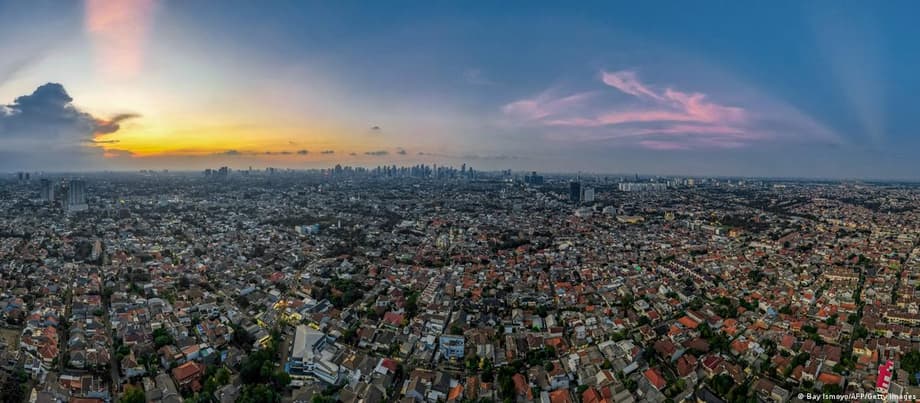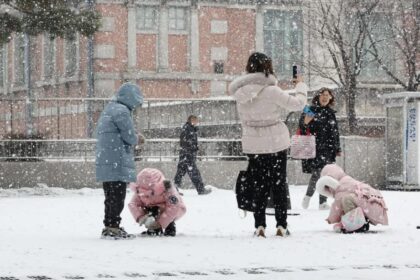A megacity at a turning point
Jakarta has reached a new global milestone. The Indonesian capital and its surrounding metropolitan area now count nearly 42 million residents, placing Jakarta at the top of the world’s city rankings by population according to recent United Nations data. That total surpasses Tokyo and Dhaka, two giants that have long defined the scale of urban life in Asia. The headline figure captures the speed and scale of change, yet the daily reality is written in commutes that stretch for hours, neighborhoods that flood with seasonal rains, and a patchwork of gleaming towers standing beside long established kampungs.
- A megacity at a turning point
- How Jakarta grew so fast
- Housing, transport, and daily life under pressure
- Floods, sinking ground, and rising seas
- Heat, air, and the green space gap
- What moving the capital really means
- How Jakarta is trying to adapt
- What could ease the pressure now
- People behind the statistics
- The Bottom Line
Density shapes much of life in Jakarta. The city’s urban core is among the most crowded on the planet, with around 22,000 people per square kilometer by local estimates. Affordable housing is scarce relative to demand. Greenery is limited, with roughly 18 percent of the city covered by vegetation and an estimated 14 percent by trees. The air often carries fine particles from vehicle exhaust, coal and diesel power, and open burning on the fringes of the metropolis. Traffic congestion, long a sore point, remains a defining feature of Jakarta’s urban experience.
Population growth here is driven mainly by migration. Many arrivals come from across the Indonesian archipelago in search of work, education, and better services. The birth rate in the urban core is comparatively low and mortality is not unusually high. At the same time, millions have shifted to the wider suburban belt that rings the capital, a fast growing zone of housing estates, factories, and logistics centers. Together, the core city and these surrounding municipalities function as a single metropolis in daily life, with shared jobs, trade, and infrastructure.
Geography adds to the challenge. Jakarta sits on a low, flat plain on the northwest coast of Java. Thirteen rivers cross the city on their way to the Java Sea. Heavy rains during the monsoon, especially when they coincide with high tides, push water into streets and homes. Land beneath the city is sinking due to groundwater extraction, and sea level along the coast is rising. These forces have combined to make flooding a persistent threat for residents and businesses alike.
How Jakarta grew so fast
Migration patterns explain much of the capital’s surge. Every year after the Eid holiday, known locally as Lebaran, newcomers follow relatives back to the city and try their luck. Authorities have tracked a recent decline in post-holiday arrivals, from more than 27,000 in 2022 to just over 16,000 in 2024, a shift linked to better self registration and a trend of settling in nearby cities that offer cheaper rents. Many new residents land first in Bogor, Depok, Tangerang, South Tangerang, or Bekasi, then commute into the capital for work.
These satellite cities form a single economic region with the core, often referred to as Jabodetabek. By 2025, estimates for the population of this megaregion were in the low forties of millions, making it one of the largest urban agglomerations on Earth. The boundaries between administrative units mean less to workers than the location of jobs, schools, markets, and bus or train lines. Jakarta’s role as Indonesia’s economic engine, with a concentration of headquarters, ports, and services, keeps the city attractive to strivers from across the islands.
The pull factors are straightforward. Wages in Jakarta usually exceed earnings in rural districts. Education and health services are more extensive. Networks of friends and family help newcomers find housing and short term work. Many migrants first stay with relatives, then move into rented rooms in kampungs or worker dormitories closer to factories and warehouses. For those with less formal education, service jobs in shops, delivery, and domestic work offer a foothold. For university graduates, Jakarta promises a wider set of careers in finance, media, technology, and government.
Housing, transport, and daily life under pressure
Housing supply has not kept pace with need. Several thousand affordable formal homes are built each year, yet the numbers fall short of demand from new households, long time residents, and workers moving from informal settlements. Kampungs, some of which have existed for generations, often provide the first landing place for arrivals. Land prices in central districts have risen sharply, and many lower income residents have shifted to the fringes where costs are lower but commutes are longer.
National statistics underline the scale of the housing gap. As of October 2025, Indonesia’s Housing and Settlements ministry counted 12.57 million families without a home of their own and 16.59 million families living in housing deemed unfit for habitation. Against a total of 75.65 million families, that puts nearly four in ten households in some form of housing precarity. The government’s Housing Finance Liquidity Facility has helped more than 1.05 million families secure decent homes over six years, but the backlog remains large. In Jakarta, the reality of a tight market is visible in crowded rentals, informal extensions to existing houses, and steady pressure for new apartments near rail lines.
Transport strains feed into daily life. The city has invested in a modern metro, light rail, and new bus corridors, which are expanding the reach of public transit. Even so, congestion remains severe because car and motorcycle ownership has grown faster than high capacity transport. Commuters routinely face trips of two hours or more. Traffic emissions and construction dust contribute to poor air quality, which varies from day to day but often exceeds health guidelines. The combination of heat, traffic, and pollution reduces productivity and stresses public health services.
Floods, sinking ground, and rising seas
Water defines Jakarta’s risk profile. Major floods have hit the area repeatedly since 1990. During the 2007 monsoon season, floodwaters submerged a large share of the city, displacing residents and interrupting commerce. Heavy rainstorms are becoming more intense in a warmer atmosphere, and sea level has been rising by a few millimeters per year. These trends make storm surges and river floods more damaging.
Why the ground keeps sinking
Parts of Jakarta are subsiding because many households and businesses draw water from underground aquifers. Removing water causes sediments to compact. In the north of the city, satellites and ground sensors have recorded subsidence of dozens of millimeters per year. By some estimates, about 40 percent of Jakarta now sits below sea level. When land sinks, drainage becomes harder, riverbanks weaken, and the reach of high tides extends inland.
Development along the coast has added to exposure. Since 1990, more than a thousand hectares of new land and artificial islands have been built in the shallow waters of Jakarta Bay. Some of these areas host upscale housing and recreation. Artificial islands often subside faster than natural soils because their fill compacts over time. Rates as high as 80 millimeters per year have been recorded on new islands, putting neighborhoods closer to storm surges and requiring constant maintenance of sea walls and drainage pumps.
To counter coastal flooding, authorities proposed the National Capital Integrated Coastal Development plan. It included a giant sea wall and a chain of 17 artificial islands meant to protect the bay and support development. Work started in the mid 2010s but slowed after environmental, technical, and financial concerns. The core idea of stronger sea defenses remains on the table. Experts caution that higher walls alone will not solve inland flooding driven by intense rains, clogged rivers, and sinking land. Reducing groundwater extraction and improving drainage across the basin are central to durable risk reduction.
Heat, air, and the green space gap
Jakarta’s built environment has expanded rapidly. One recent analysis found the built up area grew by roughly 19 percent between 2000 and 2020, while the total volume of buildings increased by about 4 percent. The city spread outward faster than it grew upward. That pattern matters because outward expansion often paves over fields and wetlands that used to absorb rainfall. Pavement and roofs retain heat during the day and release it slowly at night, creating an urban heat island that raises temperatures compared with nearby rural areas.
Green space helps cool neighborhoods, filter air, and absorb rain. With only a fraction of the city shaded by trees or parks, many districts heat up quickly during midday sun. Scientific studies in Jakarta have linked increases in urban building volume to higher levels of air pollution and stronger heat island effects. The health consequences include more respiratory illness and greater risks during heat waves, especially for older people, children, and outdoor workers. Community gardening and greening projects are gaining traction, yet scaling up shade and park access requires coordinated planning and sustained investment in streetscapes, school yards, and river corridors.
What moving the capital really means
Indonesia has decided to move the seat of government to Nusantara in East Kalimantan on the island of Borneo. The project is guided by Law 3 of 2022, with an estimated budget in the low thirties of billions of dollars. The plan unfolds in stages and relies heavily on private investment. Officials promote Nusantara as a green, smart city with renewable energy, efficient water systems, and modern public transport. Initial capacity is planned for about 1.9 million residents, with the government projecting millions of jobs by 2045. Early works were reported around one third complete by mid 2023, although timelines and scope may shift as financing and construction progress.
The move aims to reduce the pressure on Jakarta, redistribute growth beyond Java, and improve national logistics. Planners expect the first wave of roughly 16,000 civil servants to relocate from Jakarta. Skeptics point to funding risks, limited public consultation, and the difficulty of building a vibrant city from scratch. Even with the relocation, Jakarta’s role as Indonesia’s commercial hub will remain. The city’s port, airports, and financial sector tie it closely to national and regional trade. Experience in countries that created new capitals shows that the original megacity continues to grow and still requires sustained attention.
For Jakarta, the new capital presents a chance to reimagine the use of land and buildings that once served government functions. It also presents a test of coordination, since agencies based in two cities will need to work in concert. Decisions on housing, water, transport, and public health in Jakarta will still shape the daily lives of tens of millions of people. The move can ease some administrative congestion, yet it does not negate the need to fix urban basics in the capital region.
How Jakarta is trying to adapt
City leaders have articulated a resilience strategy built on collaboration between government and communities, often described as City 4.0. The approach centers on three pillars: a well prepared city that can handle shocks, a healthy city with stronger basic services, and a connected city with better mobility and access to opportunity. Efforts that fit these goals include early warning systems for floods, upgrades to drains and pump stations, restoration of riverbanks in flood prone corridors, and programs to expand access to clean water. Cutting groundwater use by growing piped water service is a priority in the fight against land subsidence.
Transport upgrades are another pillar. Jakarta has opened a first metro line and built new light rail routes, adding to the TransJakarta bus network. Integrating fares and schedules across modes helps people complete entire journeys without a car or motorcycle. The city has also invested in sidewalks and pedestrian bridges in some districts to make short trips safer and more attractive. Even with these gains, the big payoff arrives when more commutes shift from private vehicles to reliable, high capacity transport. That shift requires dense housing and jobs around stations, consistent service, and good first and last mile connections.
Community groups are central to making change visible at street level. In kampungs across the city, residents organize waste banks, plant trees, and maintain small parks. Neighborhood networks help warn of rising waters during storms. Collaboration between agencies and these local initiatives helps turn plans into projects that meet specific needs, from cleaner alleys to safer crossings near schools. The resilience strategy emphasizes this co creation model because it taps knowledge that residents hold about where water pools, where traffic is most dangerous, and which services are hardest to reach.
What could ease the pressure now
A few steps would bring gains in the near term. Enforce the spatial plan that protects floodplains and river setbacks. Restrict construction on reclaimed land until reliable protections and maintenance budgets are in place. Zone more land for affordable apartments near rail and bus corridors and support quality rental housing with basic standards for safety and sanitation. Accelerate the delivery of formal housing so that fewer families rely on unsafe structures or risky land.
Expand piped water coverage and fix leaks so that households and businesses have a dependable alternative to groundwater. Scale green infrastructure across the basin, from retention ponds to roadside rain gardens to pocket parks. Add shade trees on streets, at schools, and in markets, with an eye to doubling tree canopy in districts with the least cover. These steps reduce heat, absorb stormwater, and improve health.
Coordinate decision making across the metropolitan region. Jabodetabek functions as one labor and housing market. That reality calls for integrated planning across cities on transport, land use, and flood control. Use shared data to target investments and hold agencies accountable for outcomes that matter to residents, like travel times, flood depths, safe water connections, and air quality readings. In the long run, steady attention to these basics will unlock higher productivity and a safer, healthier city.
People behind the statistics
Numbers tell only part of the story. Each migration season, thousands arrive from Central Java, Sumatra, Sulawesi, and beyond. Many take entry level jobs in shops, warehouses, and services, saving to bring families later or to start a small business. Some employers provide dormitories that ease the first months in the city. Community associations built around hometown ties help newcomers find work, housing, and a sense of belonging. City hall encourages self registration and has shifted its posture toward welcoming economic migrants rather than policing them. Vocational training courses aim to match skills to jobs in growth sectors.
Jakarta’s unemployment count, while still high in absolute terms, has been trending lower. Yet life on the margins remains tough. Informal workers who collect and sell recyclables, sometimes known as cart dwellers, experienced hardship during the pandemic and many still lack stable shelter. For residents in flood prone neighborhoods, each heavy rain forces hard choices about safety and livelihoods. Even so, the capital’s dynamism is real. Indonesia’s biggest city keeps drawing people with its scale, diversity, and promise. Policies that expand housing, tame floods, clean the air, and ease commutes will determine how livable this giant becomes over the next decade.
The Bottom Line
- Jakarta’s metropolitan area now has nearly 42 million residents, the largest urban population on Earth
- Migration drives growth more than births, with many newcomers settling in satellite cities and commuting
- Housing is tight and costly, and millions of Indonesian families face housing precarity nationwide
- Transport congestion and air pollution remain severe despite new metro, light rail, and bus lines
- Flood risk is rising due to land subsidence, intense rainstorms, and sea level rise
- Coastal defenses alone will not solve flooding without reduced groundwater use and better drainage
- The new capital, Nusantara, aims to ease pressure on Jakarta but does not replace the need for fixes in the current megacity
- Expanding piped water, green infrastructure, and affordable housing near transit would deliver near term gains












